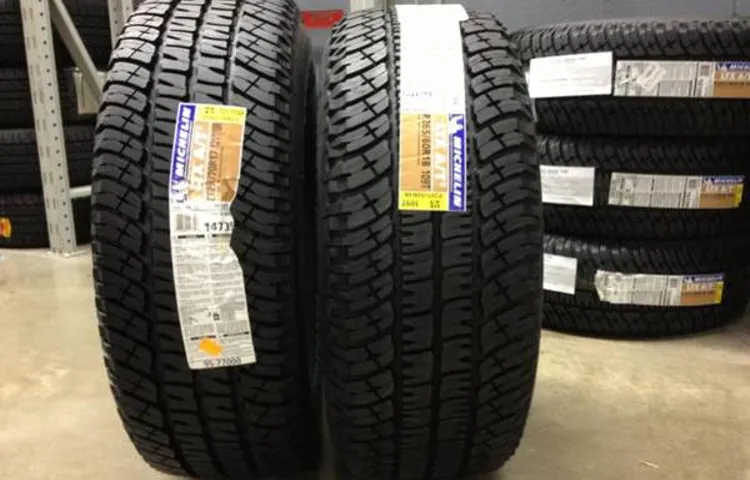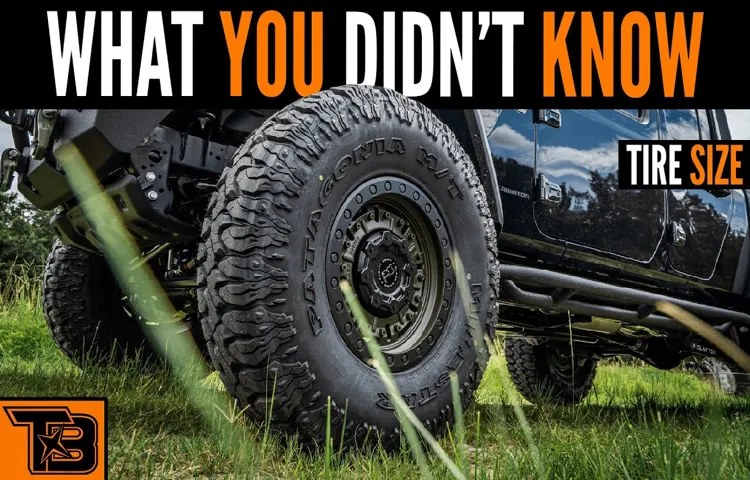Have you ever wondered what the numbers on your tire mean? Understanding tire sizes can be overwhelming, but it’s essential to know when it’s time to replace them. Not only does it affect the performance of your vehicle, but it also ensures your safety on the road. Determining tire size differences can be confusing, but it’s necessary to compare and select the right tire for your vehicle.
It’s like choosing the right shoes for a marathon runner. Just as shoes impact a runner’s performance, tire sizes can impact your vehicle’s performance. Let’s dive into the essential factors to consider when determining tire size differences.
Table of Contents
Understanding Tire Sizes
If you are looking to purchase new tires, it is important to understand the sizing options available. When it comes to comparing different tire sizes, such as a 75 and 70 tire, it can be confusing to determine the exact differences. The first number, in this case 75 and 70, represents the aspect ratio, which is the height of the tire’s sidewall as a percentage of the tire’s width.
So, a 75 tire would have a sidewall height that is 75% of its width, while a 70 tire’s sidewall would be 70% of its width. Therefore, a 75 tire would be taller than a 70 tire. However, it is important to note that the actual difference in height will depend on the width of the tire and the wheel it is mounted on.
Consulting a tire size calculator can help you better understand the exact differences between different tire sizes to ensure you choose the right option for your vehicle.
Breaking Down the Numbers
Tire sizes can be confusing, but once you understand the numbers, it becomes a lot clearer. The size of your tire is usually found on the sidewall and is represented by a combination of letters and numbers. The first set of letters indicates the tire type, such as P for passenger or LT for light truck.
The next three numbers represent the tire’s width in millimeters, followed by a slash and the aspect ratio, which is the height of the sidewall as a percentage of the tire’s width. After that, there is usually a letter that indicates the construction of the tire, such as R for radial or D for diagonal. The final number represents the rim size in inches.
For example, a tire size of P205/55R16 is a passenger tire with a width of 205 millimeters, an aspect ratio of 55%, and fits on a 16-inch rim. Understanding tire sizes can help you choose the right tire for your vehicle and ensure you get the best performance and safety.

Calculating Tire Size Differences
Calculating tire size differences may seem like a daunting task at first, but with a little understanding of tire sizes, it can become quite simple. The tire size is usually written on the side of the tire, and it consists of three numbers separated by slashes. The first number represents the width of the tire in millimeters, the second number represents the aspect ratio, which is the height of the tire’s sidewall expressed as a percentage of its width, and the third number represents the diameter of the wheel in inches.
The bigger the diameter, the bigger the tire. It’s important to note that changing the size of your tire can have consequences on your vehicle’s handling, fuel efficiency, and potentially even its safety. It’s best to consult with a professional or do thorough research before making any changes to your tire size.
Determining the Difference for a 75 vs. 70 Tire
If you’re wondering how much taller a 75 tire is compared to a 70, you’re not alone. In reality, the tire’s size will vary depending on its width, aspect ratio, and diameter. However, as a general rule of thumb, a 75 tire has an aspect ratio that’s 5% higher than a 70 tire.
This means that the sidewall of a 75 tire is 5% taller than a 70 tire. If we assume that both tires have the same diameter, then the difference in height would be approximately 0.5 inches.
However, it’s important to note that tire width and diameter can affect the actual difference in height. So, if you’re planning to switch to a 75 tire from a 70, make sure to double-check your vehicle’s compatibility and consult with a tire expert before making the switch.
Measuring the Height of the Tires
If you’re looking to measure the height of your tires, there are a few things you’ll need to consider. One of the most important factors to keep in mind is the difference between a 75 tire and a 70 tire. The number in the tire size refers to the aspect ratio, which is the height of the sidewall as a percentage of the tire’s width.
So a 75 tire will have a taller sidewall than a 70 tire. To measure the height of your tires accurately, you’ll need to measure from the ground to the highest point on the tire, taking into account the aspect ratio. This will give you a more precise measurement of the tire’s height, allowing you to make adjustments as needed.
So whether you’re looking to replace your tires or just want to keep track of your vehicle’s performance, understanding the difference between a 75 tire and a 70 tire is a crucial first step.
Calculating the Difference in Height
Calculating the difference in height between tires is important for ensuring proper vehicle operation. Determining the difference for a 75 vs. 70 tire can be a bit tricky, but it’s worth it to ensure that your car is operating at peak performance.
To calculate the difference in height, you will need to know the aspect ratio and the section width of each tire. The aspect ratio is a ratio of the height of the tire’s sidewall to the width of the tread, while the section width is the width of the tire’s tread from the outermost edge of the sidewall to the other outermost edge. Once you have these measurements, you can plug them into a tire size calculator to determine the difference in height between the two tires.
This will help you decide if it’s safe and advisable to switch to a different size of tire. Overall, it’s important to ensure that your tires are the right size for your vehicle so that you can maximize safety and performance on the road.
Interpreting the Results
When it comes to determining the difference between a 75 and a 70 tire, one must first consider the tire’s size. The numbers 75 and 70 refer to the tires’ aspect ratio, which is the height of the sidewall divided by the width of the tire. A 70 tire will have a lower sidewall height than a 75 tire, meaning it is shorter from the rim to the tread.
This difference may not be noticeable to the naked eye, but it can have a significant impact on the tire’s performance. A 75 tire is wider and has more sidewall flex, providing a smoother ride, better handling, and improved fuel economy. Meanwhile, a 70 tire may offer better steering response and cornering performance.
Overall, the difference between a 75 and 70 tire depends on personal preference and driving style, but it’s essential to choose the right size for your vehicle to ensure safe and efficient driving.
Conclusion
In answer to the age-old question, “how much taller is a 75 tire than a 70?” the only possible conclusion is that it depends on your perspective. From a mathematical standpoint, the difference is a mere 5%, hardly noticeable to the naked eye.
However, from a practical perspective, the greater clearance and increased road presence of a slightly taller tire may make all the difference, elevating your ride to new heights (literally). So whether you prefer your measurements in inches or attitude, just remember that when it comes to tires, every little bit counts!”
Factors Affecting Tire Size Differences
When considering the difference between a 75 vs. 70 tire, it’s essential to understand the factors affecting tire size differences. The most apparent variable is the aspect ratio, which determines the height of the sidewall in relation to the width of the tire.
While a 75-series tire has a higher sidewall than a 70-series tire, there are other nuances to consider. The tread width, section width, and overall diameter also impact the size difference, resulting in varying wheel revolutions per mile and speedometer readings. It’s crucial to select a tire size that meets the manufacturer’s specifications for your vehicle to ensure safety, performance, and longevity.
By consulting a tire professional or using an online tire size calculator, you can determine the proper tire size and appropriately compare different options.
Choosing the Right Tire Size for Your Vehicle
Choosing the Right Tire Size for Your Vehicle Choosing the right tire size for your vehicle can be quite a daunting task, but it is essential if you want your car to perform at its best. One of the main differences between tire sizes is the aspect ratio, which is the ratio of the height of the tire’s sidewall to its width. A 75 tire has a higher aspect ratio than a 70 tire, which means its sidewall is taller.
This can affect various aspects of your car’s performance, including handling, ride comfort, and fuel efficiency. A 75 tire may provide a smoother ride, but it may not handle as well as a 70 tire. On the other hand, a 70 tire may handle better, but it may not provide the same level of comfort on the road.
Ultimately, the decision depends on what you prioritize most in your driving experience. It is crucial to consult your vehicle’s manual and the tire manufacturer’s recommendations to ensure you choose the correct tire size for your car.
FAQs
What is the difference in height between a 75 tire and a 70 tire?
The height difference is approximately 0.5 inches.
How does the size of the tire affect the performance of a vehicle?
Larger tires generally provide better off-road performance and a smoother ride, while smaller tires offer better fuel efficiency and handling.
Can a 70 tire be replaced with a 75 tire on the same vehicle?
Yes, as long as the tire size is compatible with the vehicle and meets safety regulations.
What factors can affect the accuracy of tire size measurements?
Temperature, wear and tear, and pressure changes can all affect the accuracy of tire size measurements.
Is it necessary to replace all four tires at the same time?
It is recommended to replace all four tires at the same time for optimal performance and safety.
How can tire pressure affect the height difference between a 75 tire and a 70 tire?
Low tire pressure can result in a shorter tire height, making the difference between a 75 tire and a 70 tire appear smaller.
What is the expected lifespan of a 75 tire compared to a 70 tire?
The expected lifespan can vary based on factors such as tire quality, driving conditions, and maintenance, but generally a larger tire size (such as a 75 tire) may have a slightly shorter lifespan than a smaller tire size (such as a 70 tire).


